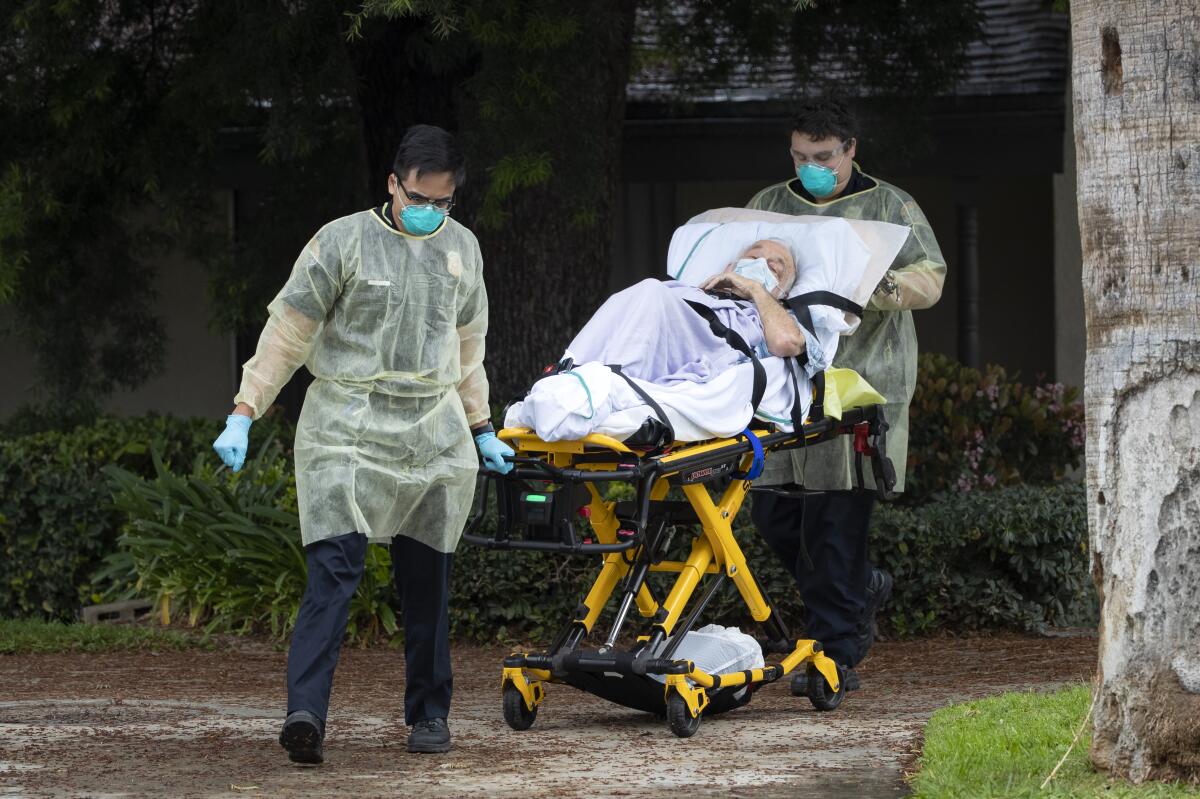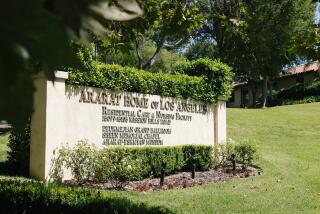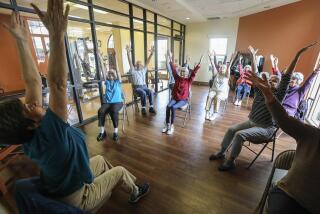Column: Increased staffing for nursing homes? Sure, but the lack of oversight is deplorable

Given the enduring scandal of shoddy care in many of the nation’s nursing homes, highlighted by the roughly 200,000 deaths in the early stages of COVID, there were high hopes for the federal government to come to the rescue.
But Friday’s long-awaited Biden administration proposal to set minimum staffing requirements, while a step in the right direction, left much to be desired.
Advocates for the more than 1 million elderly and disabled patients in nursing facilities wanted far more beefing up of current nurse-patient ratios. Meanwhile, industry representatives complained the new requirements are unfunded, even as low wages make it difficult to recruit and keep employees.
The two sides are likely to wage war during an upcoming public review of the proposal, which would be implemented nationally over a three-year period. And while that plays out, you can be sure that more patients will suffer from negligent care. That’s the way it’s always been, given the level of disregard for the elderly and disabled in American society.
California is about to be hit by an aging population wave, and Steve Lopez is riding it. His column focuses on the blessings and burdens of advancing age — and how some folks are challenging the stigma associated with older adults.
Tony Chicotel, senior staff attorney for California Advocates for Nursing Home Reform, credited Biden with following through on his 2022 State of the Union promise to address deficiencies that put patients in jeopardy. But his praise came with a caveat or two.
“I think it’s a big deal and a positive step forward for residents,” Chicotel said, citing the proposals’ higher nurse-patient ratios and a 24-7 requirement for RNs to be on site. “But Biden wanted to ensure safety and quality of care, and I don’t think these numbers ensure safety and quality care. I think they need to be higher.”
And that’s only part of the problem. Another glaring deficiency is the deplorable lack of federal and state oversight.
Chicotel has been working on an article for his agency’s fall newsletter, in which he tells the story of Sam Rios, an 87-year-old former college professor who died after developing bed sores during a two-week stay in a Roseville nursing home in 2017. Chicotel writes that a nurse at the facility testified that care there “was barbaric.”
Earlier this year, a jury in a civil case alleging elder abuse, negligence, understaffing and wrongful death awarded $30.9 million to the Rios family. But the state Department of Public Health investigation found no violations on the part of the nursing home.
“The contradiction is stunning,” Chicotel writes in his newsletter account, which carries an ominous headline:
“Has California nursing home oversight ever been worse?”
Chicotel told me there have been marginal improvements in recent years. And some facilities offer a much higher quality of care than others. But understaffing, overdue facility inspections and delays in complaint investigations continue to take a toll.
“This means enforcement actions are often rare and weak, surveys are delayed, and operators with poor track records are able to buy and run more facilities, even after they have been denied licenses in the past due to an extensive track record of poor care and regulatory noncompliance,” Chicotel writes for the newsletter.
CalMatters, in late June, offered a prime example of Chicotel’s last point:
“The state is moving forward,” the news agency reported, “with licensing two dozen nursing homes whose primary owner’s companies have a lengthy track record of problems — as uncovered by a Calmatters investigation — despite a new law designed to provide better oversight.”
So why would such an owner be allowed to stay in business? First, said Chicotel, there’s a fear on the part of state officials that if facilities are shut down, patients will have nowhere to go.
And then there’s the gradual slide toward de-institutionalization. Nursing homes are expensive, they cost taxpayers billions through Medicare and Medicaid payouts, and there’s a growing preference among patients to age at home.
But it’s not as if we’ve got that aspect of elder care figured out, either, with workforce shortages and people going broke paying for home care that’s not covered by insurance.
In California, the state provides oversight of nursing homes in all counties except one — Los Angeles. When COVID tore through the county’s nursing homes, thousands of patients were trapped in what became death chambers. By late 2021, 19,401 residents and 16,656 staff had tested positive for COVID. The death toll included 3,506 residents and 115 staff.
Those numbers are no less horrific with the passage of time. Of course, older people with pre-existing conditions were more vulnerable to the virus. But if any other age group or community of patients had been hit that hard, the level of outrage and the swiftness of the intervention—including use of protective equipment, testing and medical treatment—would have been greater. Instead, too many people died miserable deaths, often cut off from loved ones.
Shame on us.
In the wake of the carnage, the county Board of Supervisors ordered its Office of Inspector General to investigate facilities and county oversight of them, and the result was a scathing report filed in October of 2021.
The report cited widespread problems beyond the handling of COVID, including “improper backdating of records,” by county employees, even as more employees complained of being inadequately trained, overworked and pressured to rush or prematurely close complaint investigations.
The report spelled out 39 reform recommendations, including stricter enforcement against the purchase and operation of facilities by owners with shady records, some of whom use webs of affiliated companies to obscure financial dealings. It also recommended independent investigation of elder abuse cases and improper record keeping, along with other “potential misconduct or systemic deficiencies.”
Almost two years later, patient advocates have been wondering what came of the recommendations.
Molly Davies, president and CEO of Wise & Healthy Aging, helped write some of the report in collaboration with the inspector general. She said as far as she was aware, only a couple of the recommendations were implemented by the county. If there’d been a report identifying widespread deficiencies in the Sheriff’s Department, Davies said, there would have been a followup public hearing or two.
I checked with County Supervisor Kathryn Barger, who sent me several reports from the Public Health Department, the most recent in May. The reports, from department chief Barbara Ferrer, said “the majority of the improvements have been implemented or are in the final stages of implementation,” and that the board would be kept updated.
This was news to Davies, whose nonprofit runs L.A. County’s Long-term Care Ombudsman program, which means that her staff investigates complaints from patients, their loved ones, and nursing home employees (the latter group accounts for the most complaints, by the way).
As far as Davies can tell from her team’s investigations and unannounced visits to nursing facilities, systemic problems are rampant. So when I shared the documents I got from Barger, Davies said just what I was thinking: “Whatever’s been happening has been happening behind the scenes, and there’s not any accountability for it.”
Given what we’re talking about here — the health and welfare of the frailest and often most helpless among us — there’s just no excuse for not airing out every last detail of what’s wrong and how to fix it.
“I personally am not satisfied with the way skilled nursing facilities operate,” Barger told me, saying she thinks licensing, nurse-patient ratios and reimbursement rates for patient care all need to be looked at by the county and state.
She said she is “more than happy” to look into scheduling a public hearing that updates the progress on recommendations and reforms.
The sooner the better, and I’ll be watching.
In the meantime, if you’re an employee, a patient or a loved one with a complaint about care, you can get help at CANHR.org, (800) 474-1116, or go to the Wise & Healthy Aging Ombudsman page at wiseombudsman.org, or call (800) 334-9473 during working hours or (800) 231-4024 after hours.
You can also drop me a line here at Golden State, where I cover the blessings — and the many burdens — of aging.
More to Read
Sign up for Essential California
The most important California stories and recommendations in your inbox every morning.
You may occasionally receive promotional content from the Los Angeles Times.











